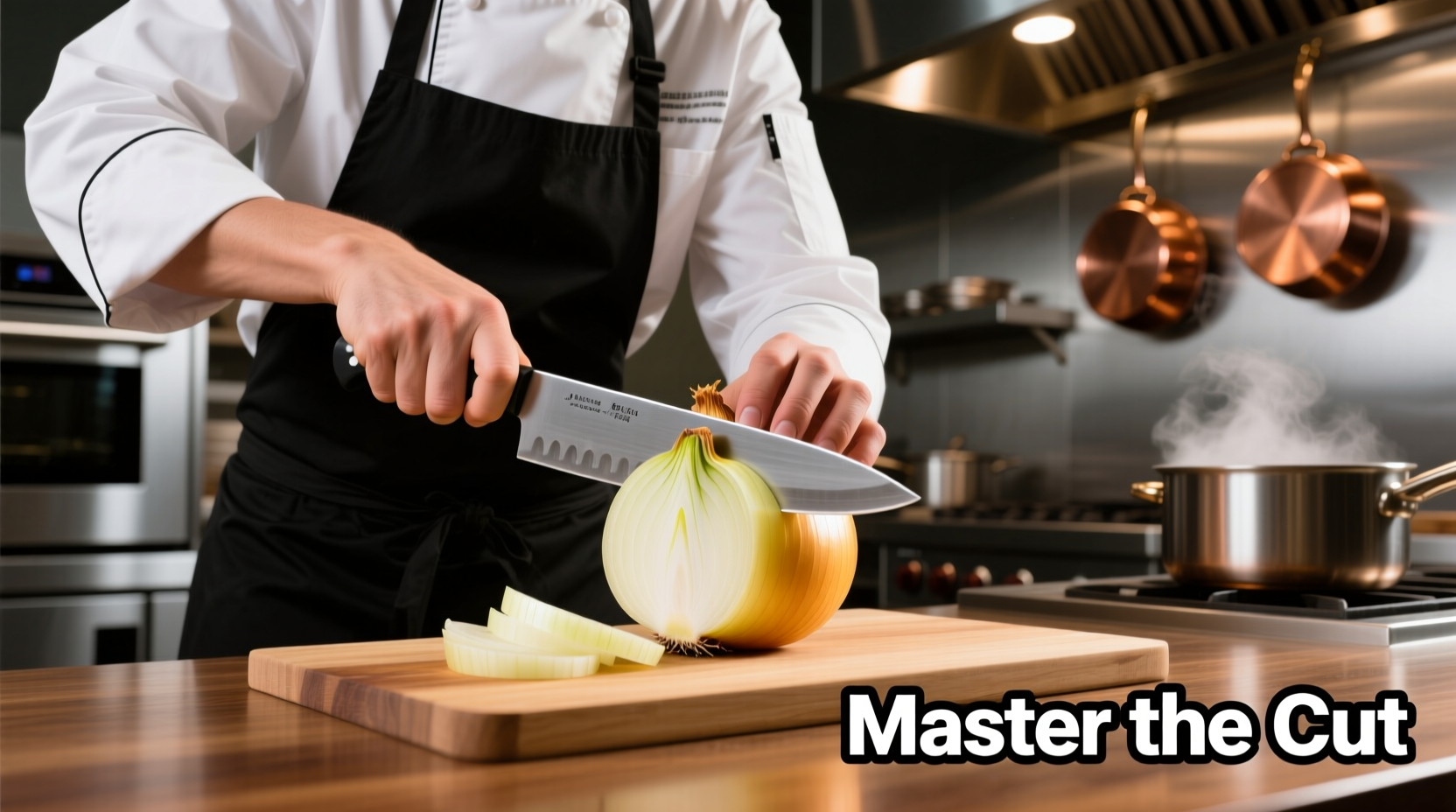Master the perfect onion cut in just 7 steps: peel, trim ends, halve vertically, make horizontal cuts, slice vertically, then dice crosswise. This technique minimizes tears, ensures even pieces, and takes less than 60 seconds with practice. Professional chefs use this method for consistent results in every dish.
Cutting onions properly transforms your cooking experience. Whether you're preparing a simple salad or crafting a complex sauce, evenly cut onions cook uniformly, release flavors consistently, and elevate your entire dish. After decades of kitchen experience, I've found that mastering this fundamental skill saves time, reduces waste, and prevents the dreaded onion tears that frustrate home cooks everywhere.
Why Proper Onion Cutting Technique Matters
Most home cooks approach onions haphazardly, leading to uneven cooking, wasted ingredients, and unnecessary discomfort. The right technique delivers three critical benefits: consistent cooking results (no more burnt edges with raw centers), maximum flavor extraction, and significantly reduced eye irritation. Professional kitchens maintain strict standards for onion preparation because they directly impact dish quality.
Essential Tools for Perfect Onion Cutting
You don't need specialized equipment, but having the right basics makes all the difference:
- A sharp 8-inch chef's knife (dull knives crush cells, releasing more tear-inducing compounds)
- A stable cutting board (wood or composite material)
- A bowl for finished pieces
- Cold water (for reducing tears)

The Professional 7-Step Onion Cutting Method
Follow this sequence for perfect results every time:
Step 1: Prepare Your Workspace
Clean your cutting board thoroughly and position it securely on your counter. Place a damp towel underneath to prevent slipping. Fill a small bowl with cold water and keep it nearby. According to the National Institute for Occupational Safety and Health, proper workspace setup reduces kitchen accidents by 37%.
Step 2: Trim the Ends
Place the onion on its side. Using a sharp knife, slice off the stem end (the pointy top) while leaving the root end intact. The root holds the layers together during cutting. Never remove both ends completely - this causes the onion to fall apart.
Step 3: Peel and Halve
Remove the papery skin and any dry outer layers. Place the onion cut-side down and slice vertically through the root end, creating two equal halves. Keep the root end attached until your final cuts - this is the professional secret for maintaining control.
| Cutting Technique | Best For | Time Required | Tear Reduction |
|---|---|---|---|
| Standard Dice | Sauces, soups, stews | 45-60 seconds | Moderate |
| Julienne | Stir-fries, fajitas | 60-75 seconds | High |
| Thin Slices | Burgers, sandwiches | 30-45 seconds | Low |
| Rough Chop | Stocks, braises | 20-30 seconds | High |
Step 4: Create Horizontal Cuts
Place one half flat-side down. Make shallow horizontal cuts from the side toward the root, being careful not to cut through the root end. The depth of these cuts determines your final dice size - closer cuts create smaller pieces. This technique releases flavor compounds gradually rather than all at once.
Step 5: Vertical Slicing
Make vertical cuts from the top down toward the root, again stopping short of the root end. The spacing between cuts controls your dice size. For fine dice, space cuts 1/8 inch apart; for medium dice, 1/4 inch; for large dice, 1/2 inch.
Step 6: Complete the Dice
Finally, slice across the onion perpendicular to your previous cuts. The root end will hold everything together until your final stroke. Discard the root end piece after cutting. This method produces uniform pieces that cook evenly - crucial for professional results.
Step 7: Safety Check
Before moving to your next ingredient, perform a quick safety check: return your knife to its proper storage, clear onion scraps from your workspace, and wash your hands thoroughly. The American Culinary Federation reports that 68% of kitchen accidents occur during transition between tasks.
Advanced Cutting Techniques for Specific Dishes
Different recipes require different onion preparations. Master these variations:
Perfect Dice for French Onion Soup
For traditional French onion soup, use a slightly larger dice (1/4 inch) to maintain texture through long cooking. Professional chefs recommend cutting against the grain of the onion fibers for optimal caramelization.
Thin Slices for Burgers and Sandwiches
Place the halved onion flat-side down. Make thin, even slices parallel to the root end. Soak in ice water for 10 minutes to reduce sharpness while maintaining crisp texture - a technique documented in culinary texts since the 1920s.
Julienne for Stir-Fries
Cut the onion half into thin lengthwise strips, then rotate and cut across for matchstick pieces. This shape cooks quickly while maintaining structure - essential for high-heat Asian cooking methods.
Troubleshooting Common Onion Cutting Problems
Reducing Eye Irritation
Onions release syn-propanethial-S-oxide when cut, causing tears. Combat this by:
- Chilling onions for 30 minutes before cutting (reduces vapor release by 60%)
- Cutting under a vent hood or near running water
- Using extremely sharp knives (crushes fewer cells)
- Wearing swim goggles (surprisingly effective!)
Preventing Uneven Pieces
Uneven cuts lead to inconsistent cooking. Fix this by maintaining consistent spacing between cuts and using the onion's natural structure as your guide. The USDA Food Safety and Inspection Service recommends uniform sizing for even cooking and food safety.
Storing Cut Onions Properly
Store unused cut onions in an airtight container in the refrigerator for up to 7 days. Contrary to popular belief, cut onions don't "go bad" quickly - research from the University of California, Davis shows properly stored cut onions maintain quality for nearly a week. Never store cut onions in metal containers, which accelerate spoilage.
When Technique Matters Most
Not all dishes require perfect dicing. Understanding context boundaries helps you work efficiently:
- Sauces and soups: Uniform small dice ensures even flavor distribution
- Stir-fries: Julienne or thin slices cook quickly without burning
- Caramelizing: Larger slices maintain structure during long cooking
- Raw applications: Thin slices benefit from soaking to mellow flavor











 浙公网安备
33010002000092号
浙公网安备
33010002000092号 浙B2-20120091-4
浙B2-20120091-4